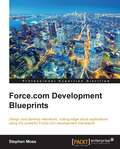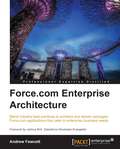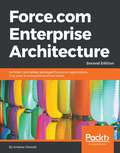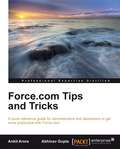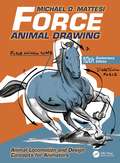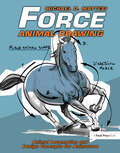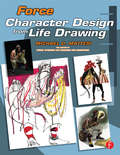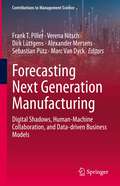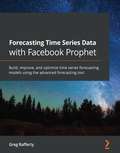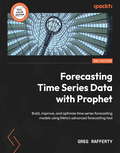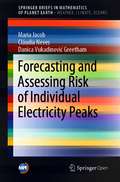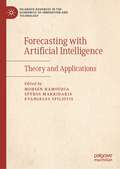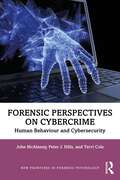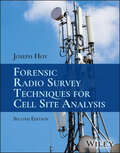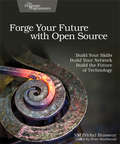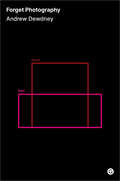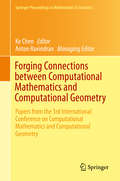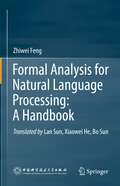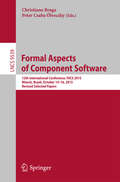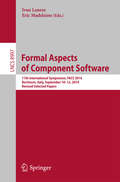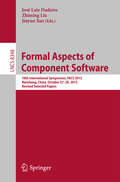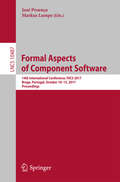- Table View
- List View
Force.com Development Blueprints
by Stephen MossThis book consists of an easy-to-follow yet comprehensive set of step-by-step tutorials that will help you gain proficiency in the Force.com platform. If you have some experience with the Force.com platform and are looking to take your skills to the next level, this is the book for you.
Force.com Enterprise Architecture
by Andrew FawcettThis book is for advanced Force.com developers and architects who need to understand the Salesforce platform from the perspective of enterprise-level requirements. You should have an existing understanding of Apex and Visualforce. Those familiar with other enterprise software ecosystems will also find this book ideal as they adopt Force.com.
Force.com Enterprise Architecture - Second Edition
by Andrew FawcettThis book is for advanced Force.com developers and architects who need to understand the Salesforce platform from the perspective of enterprise-level requirements. A prior understanding of Apex and Visualforce is a must. Those familiar with other enterprise software ecosystems will also find this book ideal as they adopt Force.com.
Force.com Tips and Tricks
by Abhinav Gupta Ankit Arora"Force.com Tips and Tricks" is not a complete reference guide for the Force.com platform development but it is a time-saving tips and tricks book that can be very helpful and handy for novice as well as experienced developers. This book would be very useful for Force.com developers who want to extend their Force.com applications using Flex, Apex, and Visualforce. "Force.com Tips and Tricks" is not a bible or a complete reference for the Force.com platform development. The time- saving tips and tricks make this book handy for novice as well as experienced developers. This is basically for Force.com developers, who want to extend their Force.com applications using Flex, Apex, and Visualforce.
Force: Animal Locomotion and Design Concepts for Animators (Force Drawing Series)
by Mike MattesiThis 10th Anniversary Edition of Force: Animal Drawing: Animal Locomotion and Design Concepts for Animators offers readers an enlarged and an enhanced selection of images that apply FORCE to animals. With larger images, readers can better appreciate and learn how to bring their own animal illustrations to life. New drawings and facts about the animals create a more comprehensive edition for your library. Readers will also adapt key industry techniques that will help personify animal animations as well as endowing their creations with human-like expressions and unique animal movement. content can be found at DrawingFORCE.com Key Features: • This full-color 10th Anniversary Edition makes FORCE even easier to understand through great diagrams and illustrations • Color-coded page edges help you find more easily the animal you want to draw • Learn about key specifications for each mammal such as their weight range, food they eat, and how fast they run • Video content can be found at DrawingFORCE.com Mike Mattesi has authored four FORCE books, published in numerous languages and utilized around the world to inspire and educate artists on the concept of FORCE. He has instructed FORCE Drawing for more than twenty-five years and inspired thousands of artists. Simultaneously, he has been contributing his skills as a professional artist on numerous award-winning projects in varied capacities and has collaborated with Pixar, Walt Disney Feature Animation, Walt Disney Consumer Products, Marvel Comics, Hasbro Toys, ABC, Microsoft, Electronic Arts, DreamWorks/PDI, Zynga, the School of Visual Arts, Beijing University, Art Center, Scuola Internazionale di Comics, San Jose State University, the Academy of Art University, Nickelodeon, LeapFrog, and many others. His students occupy all fields of the art industry and have themselves gained prestige for their abilities. Visit Michael at DrawingFORCE.com; connect with him on Facebook at DrawingFORCE.com with Mike Mattesi and at Instagram @michaelmattesi; or email him directly at mike@drawingFORCE.com. Learn more about FORCE at: DrawingFORCE.com
Force: Animal locomotion and design concepts for animators (Force Drawing Ser.)
by Michael D. MattesiMany artists are unsure how to bridge the gap between the many basic 'how to draw' books and the more advanced ones dealing with the esoteric details of composition, perspective and anatomy. Force: Animal Drawing is the comprehensive guide to developing artistic animals that are creative, dynamic and anatomical, bridging the gap between foundational art and advanced techniques. Artists and animators alike all find animal inspiration when animating characters- be they human or inhuman. For a unique 'larger than life' character, readers will learn to apply the unique facets of animal movement, locomotion, expressions, facial features, physical build and personality to their traditional and digital art. Readers will also adapt key industry tricks and techniques to personify animal animations with key characteristics of a human's face. Explore the practical application of force theories and learn from today's leading character designers with the included artist interviews and an extended video tutorial via www.drawingforce.com.
Force: Character Design From Life Drawing (Force Drawing Ser.)
by Mike MattesiDesign creative characters inspired by real people. Let Mike Mattesi show you how to use life drawing to discover the poses, features and personalities which form the basis of character and then build, develop and 'PUSH' your drawings to new heights of dramatic and visual impact for believable characters audiences can relate to.Packed with color illustrations and photographs of the models who inspired them. With step-by-step explanation of how the characters were developed and exercises for you to sharpen your skills this is everything you need to bring your characters to life.
Forecasting Next Generation Manufacturing: Digital Shadows, Human-Machine Collaboration, and Data-driven Business Models (Contributions to Management Science)
by Frank T. Piller Alexander Mertens Verena Nitsch Dirk Lüttgens Sebastian Pütz Marc Van DyckManufacturing companies have just begun to implement the concepts of the Fourth Industrial Revolution (Industry 4.0) on a larger scale. Still, this area is characterized by a rapid pace of technological change, blurring boundaries between physical, digital, and biological systems, and a quickly changing growing political, economic, and social environment -- leading to high uncertainty in decision making and many questions about the future development in this field. To provide guidance and inspiration for managers and academics on the future of digital manufacturing systems, this book presents the results of an extensive Delphi study on next-generation manufacturing systems, with a projection period of up to 2030. We analyzed almost 2000 quantitative estimations and more than 600 qualitative arguments from a large panel of industrial and academic experts from Europe, North America, and Asia. The book describes each of the 24 projections in detail, offering current case study examples and related research, as well as implications for policymakers, firms, and individuals. The empirical results also allowed us to build scenarios for the most probable future along the dimensions of governance, organization, capabilities, and interfaces from both a company-internal and an external (network) perspective.
Forecasting Time Series Data with Facebook Prophet: Build, improve, and optimize time series forecasting models using the advanced forecasting tool
by Greg RaffertyCreate and improve high-quality automated forecasts for time series data that have strong seasonal effects, holidays, and additional regressors using PythonKey FeaturesLearn how to use the open-source forecasting tool Facebook Prophet to improve your forecastsBuild a forecast and run diagnostics to understand forecast qualityFine-tune models to achieve high performance, and report that performance with concrete statisticsBook DescriptionProphet enables Python and R developers to build scalable time series forecasts. This book will help you to implement Prophet's cutting-edge forecasting techniques to model future data with higher accuracy and with very few lines of code. You will begin by exploring the evolution of time series forecasting, from the basic early models to the advanced models of the present day. The book will demonstrate how to install and set up Prophet on your machine and build your first model with only a few lines of code. You'll then cover advanced features such as visualizing your forecasts, adding holidays, seasonality, and trend changepoints, handling outliers, and more, along with understanding why and how to modify each of the default parameters. Later chapters will show you how to optimize more complicated models with hyperparameter tuning and by adding additional regressors to the model. Finally, you'll learn how to run diagnostics to evaluate the performance of your models and see some useful features when running Prophet in production environments. By the end of this Prophet book, you will be able to take a raw time series dataset and build advanced and accurate forecast models with concise, understandable, and repeatable code.What you will learnGain an understanding of time series forecasting, including its history, development, and usesUnderstand how to install Prophet and its dependenciesBuild practical forecasting models from real datasets using PythonUnderstand the Fourier series and learn how it models seasonalityDecide when to use additive and when to use multiplicative seasonalityDiscover how to identify and deal with outliers in time series dataRun diagnostics to evaluate and compare the performance of your modelsWho this book is forThis book is for data scientists, data analysts, machine learning engineers, software engineers, project managers, and business managers who want to build time series forecasts in Python. Working knowledge of Python and a basic understanding of forecasting principles and practices will be useful to apply the concepts covered in this book more easily.
Forecasting Time Series Data with Prophet: Build, improve, and optimize time series forecasting models using Meta's advanced forecasting tool, 2nd Edition
by Greg RaffertyCreate and improve fully automated forecasts for time series data with strong seasonal effects, holidays, and additional regressors using PythonPurchase of the print or Kindle book includes a free PDF eBookKey FeaturesExplore Prophet, the open source forecasting tool developed at Meta, to improve your forecastsCreate a forecast and run diagnostics to understand forecast qualityFine-tune models to achieve high performance and report this performance with concrete statisticsBook DescriptionProphet empowers Python and R developers to build scalable time series forecasts. This book will help you to implement Prophet's cutting-edge forecasting techniques to model future data with high accuracy using only a few lines of code.You'll begin by exploring the evolution of time series forecasting, from basic early models to present-day advanced models. After the initial installation and setup, you'll take a deep dive into the mathematics and theory behind Prophet. You'll then cover advanced features such as visualizing your forecasts, adding holidays and trend changepoints, and handling outliers. You'll use the Fourier series to model seasonality, learn how to choose between an additive and multiplicative model, and understand when to modify each model parameter. This updated edition has a new section on modeling shocks such as COVID. Later on in the book you'll see how to optimize more complicated models with hyperparameter tuning and by adding additional regressors to the model. Finally, you'll learn how to run diagnostics to evaluate the performance of your models and discover useful features when running Prophet in production environments.By the end of this book, you'll be able to take a raw time series dataset and build advanced and accurate forecasting models with concise, understandable, and repeatable code.What you will learnUnderstand the mathematics behind Prophet's modelsBuild practical forecasting models from real datasets using PythonUnderstand the different modes of growth that time series often exhibitDiscover how to identify and deal with outliers in time series dataFind out how to control uncertainty intervals to provide percent confidence in your forecastsProductionalize your Prophet models to scale your work faster and more efficientlyWho this book is forThis book is for business managers, data scientists, data analysts, machine learning engineers, and software engineers who want to build time-series forecasts in Python or R. To get the most out of this book, you should have a basic understanding of time series data and be able to differentiate it from other types of data. Basic knowledge of forecasting techniques is a plus.
Forecasting and Assessing Risk of Individual Electricity Peaks (Mathematics of Planet Earth)
by Maria Jacob Cláudia Neves Danica Vukadinović GreethamThe overarching aim of this open access book is to present self-contained theory and algorithms for investigation and prediction of electric demand peaks. A cross-section of popular demand forecasting algorithms from statistics, machine learning and mathematics is presented, followed by extreme value theory techniques with examples.In order to achieve carbon targets, good forecasts of peaks are essential. For instance, shifting demand or charging battery depends on correct demand predictions in time. Majority of forecasting algorithms historically were focused on average load prediction. In order to model the peaks, methods from extreme value theory are applied. This allows us to study extremes without making any assumption on the central parts of demand distribution and to predict beyond the range of available data. While applied on individual loads, the techniques described in this book can be extended naturally to substations, or to commercial settings. Extreme value theory techniques presented can be also used across other disciplines, for example for predicting heavy rainfalls, wind speed, solar radiation and extreme weather events. The book is intended for students, academics, engineers and professionals that are interested in short term load prediction, energy data analytics, battery control, demand side response and data science in general.
Forecasting with Artificial Intelligence: Theory and Applications (Palgrave Advances in the Economics of Innovation and Technology)
by Spyros Makridakis Mohsen Hamoudia Evangelos SpiliotisThis book is a comprehensive guide that explores the intersection of artificial intelligence and forecasting, providing the latest insights and trends in this rapidly evolving field. The book contains fourteen chapters covering a wide range of topics, including the concept of AI, its impact on economic decision-making, traditional and machine learning-based forecasting methods, challenges in demand forecasting, global forecasting models, meta-learning and feature-based forecasting, ensembling, deep learning, scalability in industrial and optimization applications, and forecasting performance evaluation. With key illustrations, state-of-the-art implementations, best practices, and notable advances, this book offers practical insights into the theory and practice of AI-based forecasting. This book is a valuable resource for anyone involved in forecasting, including forecasters, statisticians, data scientists, business analysts, or decision-makers.
Foreign Disinformation in America and the U.S. Government’s Ethical Obligations to Respond (Lecture Notes in Social Networks)
by Brian MurphyThe U.S. no longer has a free marketplace of ideas. Instead, the marketplace is saturated with covert foreign-backed disinformation. And despite the ethical obligations to act, successive administrations have done nothing. Additionally, the decline in trust has left the door open for populism and illiberalism to enter. Some believe the very fabric of American liberalism is at stake. So what are the ethical responsibilities of the executive branch to counter covert campaigns such as the one coming from Russian-backed disinformation circulating within the US? Why has the government failed to act? So far, the practical challenges are daunting if the executive branch addresses the threat to the homeland. The process to limit this problem is wrought with profound political implications. By its very nature, social media-based disinformation is inextricably linked with existing complex societal cleavages, the First Amendment, and politics. But the failure to do anything is a serious abdication of the government’s ethical responsibilities. This raises the question of where the line is for government intervention. This work provides answers.
Forensic Perspectives on Cybercrime: Human Behaviour and Cybersecurity (New Frontiers in Forensic Psychology)
by Peter J. Hills Terri Cole John McAlaneyForensic Perspectives on Cybercrime is the first book to combine the disciplines of cyberpsychology and forensic psychology, helping to define this emergent area. It explores the psychological factors that influence the behaviour of all those involved in cybersecurity, drawing upon the research literatures in relevant areas including forensic, social, and cyberpsychology.Written by leading figures in the field, the book provides an introduction to the cybercrime ecosystem, before discussing the psychological manipulation of targets through social engineering techniques and highlighting the unique threats that this type of attack presents. The reasons why people become involved in hacking are explored, and the authors review research literature on risk factors of being a victim of cybercrime, along with the concept of resilience. Behaviour change and prevention strategies are also evaluated, as well as the role of emergent technologies such as artificial intelligence and what this may mean for the role of humans in cybersecurity. Case studies and real-world examples are woven throughout to illustrate key issues, opportunities, and challenges.This unique text is a must-read for students undertaking any degree that relates to behaviour and cybersecurity, including psychology, computing, law, and business management. It is also highly relevant to researchers, practitioners, and policymakers who work in cybersecurity and/or have an interest in empowering people to be safe online.
Forensic Radio Survey Techniques for Cell Site Analysis
by Joseph HoyFORENSIC RADIO SURVEY TECHNIQUES FOR CELL SITE ANALYSIS Overview of the end-to-end process of planning, undertaking, and reporting of forensic radio surveying to support cell site analysis The newly updated and revised Second Edition of Forensic Radio Survey Techniques for Cell Site Analysis provides an overview of the end-to-end process of planning, undertaking, and reporting of forensic radio surveying to support the forensic discipline of cell site analysis. It starts by recapping and explaining, in an accessible way, the theory, structure, and operation of cellular communications networks, then moves on to describe the techniques and devices employed to undertake forensic radio surveys. Worked examples are used throughout to demonstrate the practical steps required to plan and undertake forensic radio surveys, including the methods used to analyze radio survey data and compile it into a court report. A summary section condenses the technical and practical elements of the book into a handy reference resource for busy practitioners. The Second Edition contains 25% brand new material covering 5G New Radio networks and ‘6G and beyond,’ critical communications, mobile satellite communications, IoT networks, Cell Site Analysis Tools, and much more. Other sample topics covered in Forensic Radio Survey Techniques for Cell Site Analysis include: Radio theory, covering RF propagation, basic terminology, propagation modes, multipath transmission, and carrying information on a radio signal Core networks, including 2G, 3G, 4G, and 5G, subscriber and device identifiers, and international and temporary mobile subscriber identities Cell access control, covering cell barring, forbidden LAC/TAC, location updating, inter- and intra-carrier handovers, and 3GPP network types Forensic radio surveys objectives, terminology, and types, along with location, static spot, and indoor surveys The Second Edition of Forensic Radio Survey Techniques for Cell Site Analysis is an essential reference on the subject for police analysts, practitioners, technicians, investigators, and cell site experts, along with legal professionals and students/trainees in digital forensics.
Forensic Speaker Recognition
by Amy Neustein Hemant A. PatilForensic Speaker Recognition: Law Enforcement and Counter-Terrorism is an anthology of the research findings of 35 speaker recognition experts from around the world. The volume provides a multidimensional view of the complex science involved in determining whether a suspect's voice truly matches forensic speech samples, collected by law enforcement and counter-terrorism agencies, that are associated with the commission of a terrorist act or other crimes. While addressing such topics as the challenges of forensic case work, handling speech signal degradation, analyzing features of speaker recognition to optimize voice verification system performance, and designing voice applications that meet the practical needs of law enforcement and counter-terrorism agencies, this material all sounds a common theme: how the rigors of forensic utility are demanding new levels of excellence in all aspects of speaker recognition. The contributors are among the most eminent scientists in speech engineering and signal processing; and their work represents such diverse countries as Switzerland, Sweden, Italy, France, Japan, India and the United States. Forensic Speaker Recognition is a useful book for forensic speech scientists, speech signal processing experts, speech system developers, criminal prosecutors and counter-terrorism intelligence officers and agents.
Forge Your Future with Open Source: Build Your Skills. Build Your Network. Build the Future of Technology.
by Vm Vicky BrasseurFree and open source is the foundation of software development, and it's built by people just like you. Discover the fundamental tenets that drive the movement. Take control of your career by selecting the right project to meet your professional goals. Master the language and avoid the pitfalls that typically ensnare new contributors. Join a community of like-minded people and change the world. Programmers, writers, designers, and everyone interested in software will make their mark through free and open source software contributions. Free and open source software is the default choice for the programming languages and technologies which run our world today, and it's all built and maintained by people just like you. No matter your skill level or area of expertise, with this book you will contribute to free and open source software projects. Using this practical approach you'll understand not only the mechanics of contributing, but also how doing so helps your career as well as the community. This book doesn't assume that you're a programmer, or even that you have prior experience with free and open source software. Learn what open source is, where it came from, and why it's important. Start on the right foot by mastering the structure and tools you need before you contribute. Choose the right project for you, amplifying the impact of your contribution. Submit your first contribution, whether it's code, writing, design, or community organising. Find out what to do when things don't go the way you expect. Discover how to start your own project and make it friendly and welcoming to contributors. Anyone can contribute! Make your mark today and help others while also helping yourself.
Forget Photography
by Andrew DewdneyWhy we must forget photography and reject the frame of reality it prescribes and delineates.The central paradox this book explores is that at the moment of photography's replacement by the algorithm and data flow, photographic cultures proliferate as never before. The afterlife of photography, residual as it may technically be, maintains a powerful cultural and representational hold on reality, which is important to understand in relationship to the new conditions. Forgetting photography is a strategy to reveal the redundant historicity of the photographic constellation and the cultural immobility of its epicenter. It attempts to liberate the image from these historic shackles, forged by art history and photographic theory. More important, perhaps, forgetting photography also entails rejecting the frame of reality it prescribes and delineates, and in doing so opens up other relationships between bodies, times, events, materials, memory, representation and the image. Forgetting photography attempts to develop a systematic method for revealing the limits and prescriptions of thinking with photography, which no amount of revisionism of post-photographic theory can get beyond. The world urgently needs to unthink photography and go beyond it in order to understand the present constitution of the image as well as the reality or world it shows. Forgetting photography will require a different way of organizing knowledge about the visual in culture that involves crossing different knowledges of visual culture, technologies, and mediums. It will also involve thinking differently about routine and creative labor and its knowledge practices within the institutions and organization of visual reproduction.
Forging Connections between Computational Mathematics and Computational Geometry
by Ke Chen Anton RavindranThis volume presents original research contributed to the 3rd Annual International Conference on Computational Mathematics and Computational Geometry (CMCGS 2014), organized and administered by Global Science and Technology Forum (GSTF). Computational Mathematics and Computational Geometry are closely related subjects, but are often studied by separate communities and published in different venues. This volume is unique in its combination of these topics. After the conference, which took place in Singapore, selected contributions chosen for this volume and peer-reviewed. The section on Computational Mathematics contains papers that are concerned with developing new and efficient numerical algorithms for mathematical sciences or scientific computing. They also cover analysis of such algorithms to assess accuracy and reliability. The parts of this project that are related to Computational Geometry aim to develop effective and efficient algorithms for geometrical applications such as representation and computation of surfaces. Other sections in the volume cover Pure Mathematics and Statistics ranging from partial differential equations to matrix analysis, finite difference or finite element methods and function approximation. This volume will appeal to advanced students and researchers in these areas.
Formal Analysis by Abstract Interpretation: Case Studies in Modern Protocols (SpringerBriefs in Applied Sciences and Technology)
by Benjamin AzizThe book provides a gentle introduction and definition of the denotational-based abstract interpretation method. The book demonstrates how the above method of formal analysis can be used, not only to address the security of systems, but other more general and interesting properties related to the testing, mutating and semantic ambiguity resolution of protocols. The book presents three case studies, all related to current complex protocols and standards used in industry, particularly in the context of IoT and Industry 4.0.
Formal Analysis for Natural Language Processing: A Handbook
by Zhiwei FengThe field of natural language processing (NLP) is one of the most important and useful application areas of artificial intelligence. NLP is now rapidly evolving, as new methods and toolsets converge with an ever-expanding wealth of available data. This state-of-the-art handbook addresses all aspects of formal analysis for natural language processing. Following a review of the field’s history, it systematically introduces readers to the rule-based model, statistical model, neural network model, and pre-training model in natural language processing. At a time characterized by the steady and vigorous growth of natural language processing, this handbook provides a highly accessible introduction and much-needed reference guide to both the theory and method of NLP. It can be used for individual study, as the textbook for courses on natural language processing or computational linguistics, or as a supplement to courses on artificial intelligence, and offers a valuable asset for researchers, practitioners, lecturers, graduate and undergraduate students alike.
Formal Aspects of Component Software
by Peter Csaba Ölveczky Christiano BragaThis book constitutes the revised selected papers fromthe 12th International Conference on Formal Aspects of Component Software, FACS2015, held in Niterói, Brazil, in October 2015. The 15 full papers and 2 invited papers presented in thisvolume were carefully reviewed and selected from 33 submissions. They areorganized in topical sections, namely quality of service to withstand faults,component-based software development through research on mathematical modelsfor components, composition and adaptation; rigorous approaches toverification, deployment, testing, and certification.
Formal Aspects of Component Software
by Ivan Lanese Eric MadelaineThis book constitutes revised selected papers from the International Symposium on Formal Aspects of Component Software, FACS 2014, held in Bertinoro, Italy, in September 2014. The 20 full papers presented in this volume were carefully reviewed and selected from 44 submissions. They are organized in topical sections named: compositional approaches; adaptation and evolution; application and experience; tools; scheduling, time and hybrid systems; other verification approaches and safety and liveness of composition. The volume also contains two invited talks, one full paper and one abstract.
Formal Aspects of Component Software
by Zhiming Liu José Luiz Fiadeiro Jinyun XueThis book constitutes the revised selected papers of the 10th International Symposium on Formal Aspects of Component Software, FACS 2013, held in Nanchang, China, in October 2013. The 19 full papers and three invited talks presented were carefully reviewed and selected from 51 submissions. The papers are concerned with how formal methods can be used to make component-based development fit for the new architectures of today and the systems that are now pervading the socio-economic worlds.
Formal Aspects of Component Software
by José Proença Markus LumpeThis book constitutes revised selected papers of the 7th International Workshop on Formal Aspects of Component Software, FACS 2010, held in Guimar#65533;es, Portugal, in October 2010. The 13 full papers and 4 short papers presented together with 1 panel discussion and 2 invited talks were carefully reviewed and selected from 37 submissions. The workshop seeks to develop a better understanding on how formal methods can or should be used for component-based software development to succeed.
